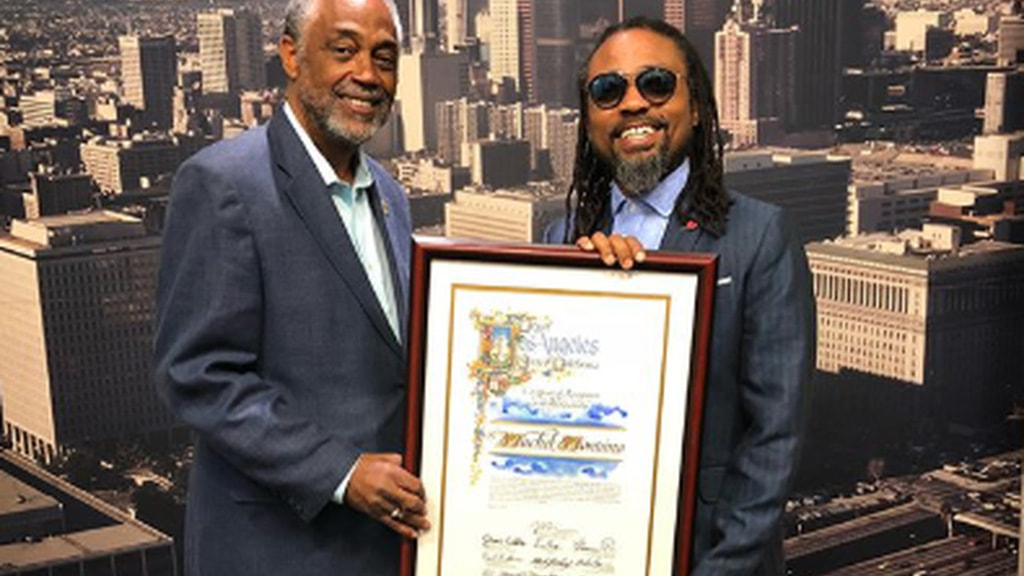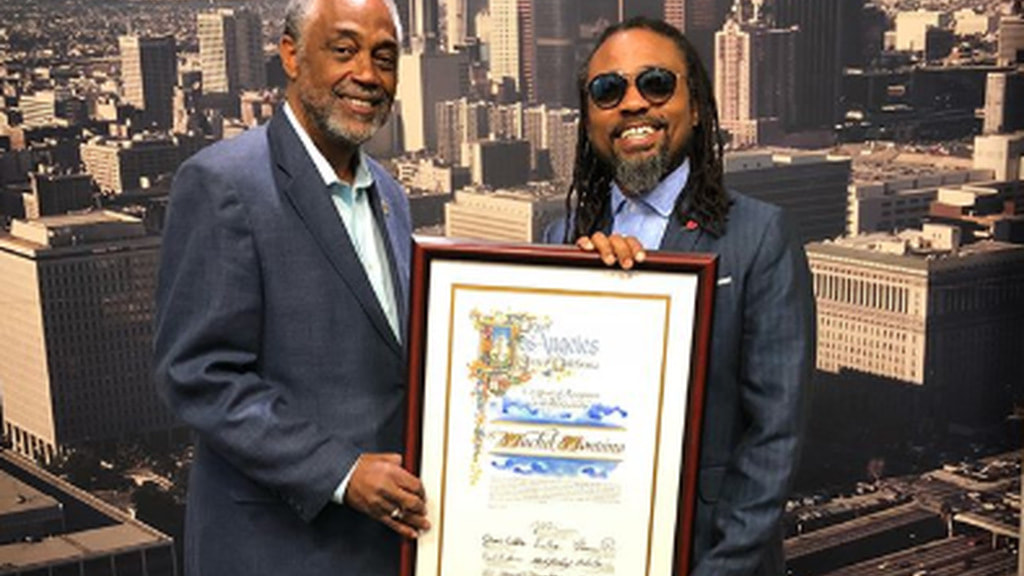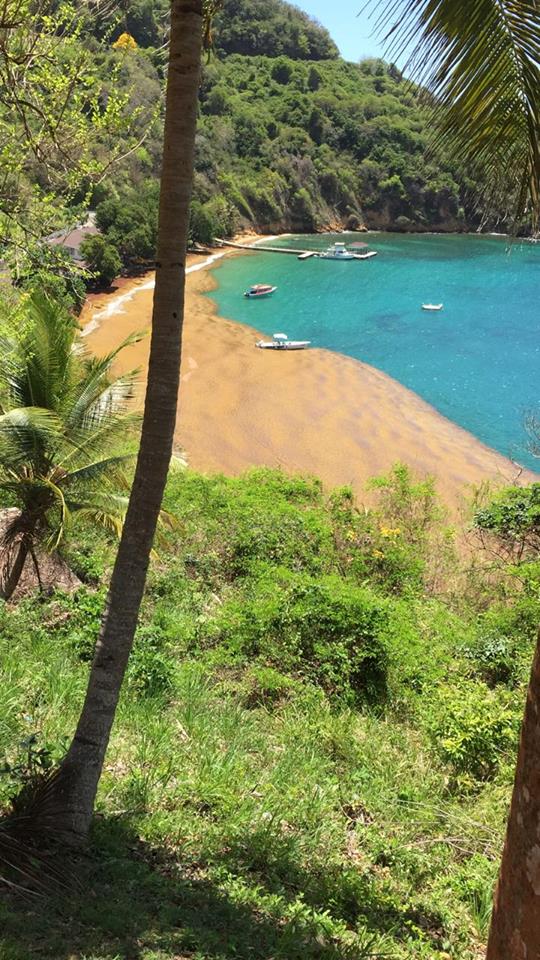 Machel Montano has been honoured for his work promoting Caribbean culture. The soca superstar was honoured on Friday night at the Los Angeles 2nd Annual Caribbean Recognition Day which was held ahead of the Hollywood Carnival parade today. Montano was honoured along with Puerto Rican actress Jeimy Osorio. The ceremony was held by Councilmember Marqueece Harris-Dawson in association with the Los Angeles Culture Festival. In his post on Instagram, Montano expressed thanks for the recognition. "Flew in from Chicago this morning and made it to City hall just in time. I’m honoured to receive recognition from the City of Los Angeles today on LA's Caribbean Heritage Day!! Come celebrate our heritage all weekend with us at @hollywoodcarnival," he wrote. Source: The Loop, July 3
0 Comments
 For the seventh time, Trinidad and Tobago has copped the title of Caribbean National Culinary Team at Taste of the Caribbean. The annual culinary competition took place from June 22 to June 26 at the Hyatt Regency Miami. Team T&T also captured the titles of Best Non-Alcoholic Cocktail, Caribbean Bartender of the Year, Caribbean Chef of the Year (Beef Category). The winning team includes: Team Captain: Jeremy Lovell (Courtyard by Marriott) Senior Chef: Rondell Thompson (Chaud Cafe) Senior Chef: Tricia Gregoire (Kiddies Cook Culinary Program) Junior Chef: Zaria Sealey (Heroes Restaurant and Sports Bar) Pastry Chef: Anton Lee James (Hyatt Regency) Bartender: Shana Rajahram (Shana Stirs it Up) Alternate Bartender: Dale Sebro-Jospeh (Trini Bartenders) Trinidad and Tobago bested Barbados, the reigning champions of 2017 and several other Caribbean territories including Bahamas, Belize, Bonaire, Cayman Islands, Curaçao, Jamaica, St. Lucia, Suriname, and Turks and Caicos. Hosted by the Caribbean Hotel and Tourism Association (CHTA), each team selected their best chefs and mixologists from their country to vie for several titles including Caribbean Chef of the Year, Caribbean Bartender of the Year, Caribbean Pastry Chef of the Year, and Caribbean Junior Chef of the Year. The members of the T&T National Culinary Team 2018 were an immediate hit at the CHTA’s ‘Caribbean305’ event held on June 23 at Jungle Island. Their mouth-watering offerings of geera pork, curried chicken, eggplant and tomato pholourie (with a range of sauces), and a sorrel swizzle rum cocktail were all in high demand by patrons from both the Caribbean and Southern Florida, and their booth was cleared out within the first hour. For the Team of the Year competition dinner held on June 24, the National Culinary Team presented a scrumptious, well-executed three-course dinner offering that creatively infused many of Trinidad & Tobago’s local flavours and spices, much to the delight and appreciation of the judges and diners alike. Trinidad & Tobago won a Gold medal for this dinner offering. Team members also participated in several Individual competitions where they amassed six additional medals including one Gold, one Silver, and 4 Bronze. Trinidad and Tobago has a known track record for performing exceptionally well over the years at the competition, with a total of 87 medals (including 40 Gold, 31 Silver, and 16 Bronze), numerous individual titles such as Caribbean Bartender of the Year; Caribbean Junior Chef of the Year; Caribbean Chef of the Year; and Caribbean Pastry Chef of the Year. The country has also earned the coveted title of Caribbean National Team of the Year six times--2004, 2006, 2007, 2009, 2011, and 2016--a feat that continues to be unmatched by any other participating destination. "The THRTA recognizes the pivotal role that its hospitality training institute, the Trinidad & Tobago Hospitality & Tourism Institute (TTHTI) continues to play in achieving these successes, given that five of the six members of the 2018 T&T National Culinary Team are either past or present students of the TTHTI. The THRTA and the TTHTI remain committed to the development of Trinidad & Tobago’s youth by providing them with a regional platform and relevant training to expand their culinary and bartending skills," according to a media release by THRTA on Wednesday. "The THRTA sees this continued culinary excellence as a compelling value proposition for Destination T&T to attract international tourists to share in our cuisine, culture and local experiences. Additionally, the continued, demonstrated success on the international stage creates opportunities for the development of our young citizens and the establishment of defined career pathways within the local hospitality and tourism sector." Source: the Loop, June 27, 2018  Machel Montano has been honoured for his work promoting Caribbean culture. The soca superstar was honoured on Friday night at the Los Angeles 2nd Annual Caribbean Recognition Day which was held ahead of the Hollywood Carnival parade today. Montano was honoured along with Puerto Rican actress Jeimy Osorio. The ceremony was held by Councilmember Marqueece Harris-Dawson in association with the Los Angeles Culture Festival. In his post on Instagram, Montano expressed thanks for the recognition. "Flew in from Chicago this morning and made it to City hall just in time. I’m honoured to receive recognition from the City of Los Angeles today on LA's Caribbean Heritage Day!! Come celebrate our heritage all weekend with us at @hollywoodcarnival," he wrote. Source: The Loop, June 24, 2018 Keshorn Walcott opened his 2018 campaign with gold at a meet in Aanekoski, Finland, on Thursday. The 2012 Olympic champion produced a 78.58 metres effort to claim the men’s javelin title. Walcott took three throws, landing the spear 75.44m, 78.58m and 77.33m. The Trinidad and Tobago throwing star fouled once, and passed on his last two attempts.
Walcott forced Finland’s Jami Kinnunen and Toni Liflander to settle for second and third, respectively. Kinnunen threw 75.50m, and Liflander 72.12m This unsung hero, Former BWIA pilot, Capt. Michael Rezende has folded his wings on June 16, 2018. His good friend and a pilot too, Darrell Lou-Hing, wanted to let you know that Michael died at 10:06 a.m Barbados time....very peacefully ......😪😪😪He was 72 his birthday would of been July 16. Darrel does not have access to the BWIA sites....and has asked that this message be posted so that his friends will know and that his life and accomplishments live on......😪 He fought a good fight, but really missed being able to jump in his car and go to the beach for his swim, could not ride his motorcycle.....So all those restrictions are gone. Here is the story that I am sure most of you never knew.  May 1, 1970 1970 BWIA HIJACKED BW 400 Capt.Keith Melville, Mike Rezende, Michael Bower May 1, 1970, Jennifer Hanna, then Selman, was the purser aboard the flight which originated in Trinidad and Tobago, with scheduled stops in Jamaica and the Grand Cayman. Jennifer Selman, found herself at the centre of a hijacking drama aboard a British West Indian Airways (BWIA) Boeing 727 Sunjet enroute from Kingston to Miami, which absolutely terrified her. "We had just taken off from Kingston and I was standing in the galley when two men approached from the economy class. I instinctively went up to them and asked if I could help, because they were headed to the first-class section which was not allowed." The men, Black North Americans, never answered. Instead they put a knife to the neck of air hostess, Elizabeth Wrigley and told her to go to the cockpit. "She didn't see what was happening as she wasn't facing them, however, I saw clearly and so I said 'Go Liz go, just go' I then pressed the emergency several times to alert the captain." First Officer Michael Rezende said that “the cockpit door was opened and he saw Elizabeth Wrigley being force-ably held by a large Black guy with a knife to her throat and a gun that looked like a German Luger who held his gun to my head, declared to the crew that this flight is “Afro American Freedom Fighters One.” This was in the framework of American Black Power activism in America. Flight Engineer Michael Bower told the Hijacker that this aircraft cant fly to Africa for lack of sufficient fuel. The Hijacker replied that we will then land in the sea. Michael Bower then suggested in his wisdom, Why dont we fly to Trinidad where he can commandeer a Boeing 707 which could carry enough fuel to get to Africa. This clearly annoyed the hijacker who pointed the gun to Bowers head and said, You will be the first to die”, then pointing the gun to the Captian Melville, “and You second.” Realising that this was a nut case, Rezende, in an effort to calm the situation, said to the Hijacker, “ But you are Hijacking the wrong airline, all of us in the Caribbean are Black. We have Black Power.” This seemed to please the hijacker and hold Rezende in favor as he turned to the flight attendants in the galley, “ You see this Man, bring him anything he wants Coffee, cigarettes anything.”He then let Elizabeth go and she exited the cockpit, the hijacker then demanded that the Captain change course and fly to Algiers. Bower then showed the hijacker the flight log which showed the #2 engine was loosing oil and needed to be topped up frequently. This seemed to put some doubt in the hijackers mind about the aircraft. One of the hijackers announced from the cockpit, "This is your new commander and the flight's name is changed to AAFF, Afro American Freedom Flight Number One." The Captain then suggested that they stop in Cuba to refuel and put some oil in the engine."At first they said he should put the oil in engine number one into engine number two, and the captain explained that that would take at least two days with the help of a trained engineer. Instead of flying to Miami, the aircraft was forced to go to Havana, Cuba where the men held the 63 passengers, including the crew, hostage for approximately seven hours while demanding that the plane be refuelled and flown to Algiers for a meeting with American Author Eldridge Cleaver, a Black Panther who was living there in exile. "It was really terrifying. They had a map with them and they were pointing out from a layman's perspective how they wanted to go from Cuba to Guyana, from Guyana to Natal in Brazil and then to Dakar, Africa. They were talking about uncharted territory and all the time I remember thinking that they might kidnap me and keep me in Africa since I was the only visibly black crew member," said Hanna. F/O Rezende attempted to set the Transponder to the international distress code for a hijack but the hijacker said “ Dont Fuck with that!” making the crew realise that he knew something about aircraft. Communications were made with Havana and permission to land was recieved from the Cuban Authorities. Wesley Chang, BWIA Area Manager for Jamaican and the Grand Cayman Islands said the two hijackers, identified as Robert Wiggins of New York and Robert Alonzo of North Carolina wanted to go to Senaga a Republic in Africa. Quick-thinking and experienced captain, Keith Melville who told the men, who threatened to shoot up the passengers and throw their bodies outside, that there was a leak in the second engine. On landing in Havana airport Rezende observed many fox holes dug around the perimeter of the runway with armed soldiers and anti aircraft gun emplacements, they were prepared for war. Capt Melville put the aircraft firmly on the ground and applied full reverse thrust as approaching fast from the other end of the runway directly at the aricraft was cherry picker vehicle ( like what T&TEC uses to fix wires) with the arm fully extended and in its bucket were armed soldiers with automatic weapons pointing directly at the cockpit. The aircraft was immediately surrounded by military vehicles and troops. As soon as the aircraft came to a stop on the runway the cherry picker pulled up to the captain side window and the soldiers pointed their weapons directly at those in the cockpit who made hand signals to shut down engines and open the window and cabin door. There must have been another truck with an air stair and the Cabin door was opened from the outside and a well dressed Cuban authority entered the cockpit and spoke in perfect English, who said “ Only One Hijacker , why did you not tell us? We would have shot him out as we approached the aircraft!” Rezende thought, “You not serious? you would shoot the terrorist behind Capt Melville?” The Authority then quite nonchalantly declared, “ get the Passengers and Baggage off the aircraft!” and told the Captain, “That’s US$50,000:00 for landing fees and US$50,000:00 for hotel accommodation!” Captain Melville protested that he did not have US$100,000:00. “No Problem, call Trinidad, have them call Mexico, Mexico will send money tomorrow! No Problem!” "The hijackers walked off the plane straight into the arms of the Cuban authorities and that was that, end of drama. We asked the Cuban Authorities what would happen to the Hijackers? They replied “If genuine counterrevolutionaries we will train and send out, if not, they will cut cane!” Passengers and crew were put on a bus and taken to downtown old Havana with its old Spanish Colonial buildings and to a hotel where everyone was assigned and individual room. The Cuban Authority told them they could go anywhere they liked in Havana but not out of the front door. At Dinner time everyone was called down for dinner which they expected would be on the ground floor but the elevator would only go as far as the 4th floor, where dinner was served. Next day the crew was informed that the Mexicans had paid the required fees and they were free to leave, the bus took them back to the airport where they boarded and cleared for takeoff and to the Cuban airspace boundary, where the US Air Force escorted them to Miami. Joseph Denicola, Manager for North America operations, said the hijackers had surrendered to Cuba officials and the aircraft will continue to Miami. After being Hijacked on Friday the Aircraft was released by Cuban Authorities on Saturday and allowed to fly on to Miami. On Arrival in Miami Rezende said, we were met by every imaginable Government agency, FBI,CIA, Police Dept etc. And every one was interviewed numerous times individually. The next day, says Rezende, "we operated BW 401, on time, back to Port of Spain, in spite of our stress. To this day there has never been a company inquiry as to what took place so that it may not happen again. BWIA displayed absolutely no interest whatsoever as to what happened although we (Capt Melville and Mike Rezende) submitted a written report of the incident. And the crew never received either a letter of commendation or acknowledgment." “I do think the crew under the command of Keith Melville did an outstanding job considering that we have never had any training on how to handle such a situation, there were no hysterics, screaming or anything it just worked itself out completely calmly, must have been for the good training that the older wartime pilots and the past war experience together with the excellent training of Bidi Bell and Janet Scott .” BWIA’s management and the Government of Trinidad & Tobago’s response to this life threatening incident was non existent and Staff were not told of the event, very poor in that it made no effort to analyse the implications of it and prepare and train all of its staff on how to deal with such incidents should they reoccur in the future, it was just swept under the carpet. Source: his friend Darrell Lou-Hing TT’s Men’s 4x100 relay team of (from left) Emmanuel Callender, Marc Burns, Keston Bledman and Richard Thompson will be awarded gold after the Court of Arbitration for Sport (CAS) yesterday dismissed Nesta Carter’s appeal against the ruling to strip Jamaica of its relay title at the 2008 Beijing Olympic Games. TT’s 4x100m team will receive gold medals a decade after the Beijing Olympics after the Court of Arbitration for Sport (CAS) yesterday dismissed Nesta Carter’s appeal against the ruling to strip Jamaica of its relay title.
Carter appealed the CAS decision in February after testing positive for methylhexaneamine, a banned stimulant, in 2016, eight years after the sample was collected. Marc Burns, Keston Bledman, Richard Thompson, Emmanuel Callender and Aaron Armstrong were on the TT relay team that was initially awarded silver after clocking 38.06 seconds. With the ruling, Japan and Brazil were confirmed as the silver and bronze medal winners, respectively. The result of the decision also meant Michael Frater and Asafa Powell lost their gold medals along with Bolt, who can no longer lay claim to a historic gold medal three-peat (100, 200 and 4x100m) at three consecutive Olympic games (2008-2016). The CAS judgment noted: “We (do) not accept any of the arguments raised by Nesta Carter contending that the test results should be ignored or that the decision should otherwise be overturned for certain alleged failures.” It continued: “Accordingly, the CAS panel dismissed the appeal and the decision is confirmed.” Carter was also part of the Jamaica 4x100m team that beat TT for gold at the 2012 London Olympics, as well as the 4x100 relay teams that won gold at the World Championships in 2011, 2013 and 2015. The news was both expected and welcomed by the TT team. Speaking with Newsday yesterday, Burns said while receiving the gold medals in 2008 would have been more impactive, he and his team-mates can celebrate their positions among the world’s elite runners. “At that time Trinidad and Tobago’s achievement would have been more monumental with the medal haul… and (my) team-mates could have benefited financially with the gold medal,” the 35-year-old said. “But, the fact still remains with this confirmation, the team will be part of an elite fraternity of Olympic gold medallists, and that title cannot be taken from us.” Burns sympathised with Bolt and the other Jamaican athletes who were penalised for Carter’s actions. “(However) it is still disheartening for clean athletes to lose out when we try do things the right way,” he said. “Bolt’s legacy has already been cemented as one of the greatest athletes to ever grace the sport of track and field and his achievements will remain for generations to come.” Newsday also spoke with TT Olympic Committee (TTOC) president Brian Lewis who said the local governing body will wait until it receives official correspondence from the International Olympic Committee (IOC) before making a full statement. Pending this communication, Lewis said “it’s (still) one of those moments where it’s not an overwhelming sense of jubilation or triumph” given the time lapse and the repercussions for the Jamaican athletes. “It will always be a bitter sweet scenario because we are one Caribbean people,” he said. Lewis lauded the IOC for its “determination to address the issue of doping in sport.” “The T&T Olympic Committee, which is in fact the de facto national anti-doping organisation at this point in time, remains firmly committed to clean sport and clean athletes,” said Lewis. Source: Newsday, May 31, 2018 Front (L-R): Yoland La Pierre (NGC Director), Charise Laveau, Shanade Ali, Chaela Wooding, Jenae Edwards, Shaniah Rudden, Jeanelle Looby (Teacher) Middle: (L-R) James Mohammed, Ethan Wilson, Nicholas Maharaj, Phillip Janes, Brian Ripoll, Arendel Owen Back (L-R): Zachary Joel, Daniel Harper, Sebastian Rudden, Conrad Taitt, Brandon Wooding, Deron Khelawan, Ruth Rudden (Teacher).. ST. AUGUSTINE, Trinidad, Wednesday June 18, 2014 – You wouldn’t normally expect to hear a conversation about “ionization in the earth’s atmosphere” happening between a group of twelve to fourteen year-old youngsters. But that conversation is exactly what led enterprising youth from the Caribbean nation of Trinidad and Tobago to the top prize in the Cubes In Space global contest.
Seven students from NorthGate College, in Trinidad and Tobago, captured the 2014 Cubes In Space™ MPAC Group Top Design Award, for a science experiment that will be launched into space on June 26. One member of the team, thirteen-year-old, Deron Khelawan confidently explained, “the Ionization Investigation seeks to measure the extent to which an electromagnetic field is generated as the payload moves through the ionosphere.” Their creative idea did not only impress their teachers and parents; it impressed a global panel of judges that included some of the finest minds in the aerospace industry. “The quality of thought and depth of understanding of the science behind their experiment far exceeded most of what was submitted to us by other schools and countries. The NASA engineers to whom we have shown the proposal and video were utterly impressed and astounded that the application was submitted by middle-school aged students,” said Agee-DeHart, Founder of the Cubes In Space program. The Cubes In Space program is a partnership between Rubik Learning Initiative, idoodlesoftwareinc., the Colorado Space Grant Consortium’s RockSat-C program and supported by the Sounding Rocket Program Office at NASA’s Wallops Flight Facility. Yolande La Pierre, Director at the St Augustine-based secondary school was elated when she received news of the award. “This achievement is a real testament to the potential that lives within our children. It means a lot for us and for our education system to see their creativity, determination and teamwork rewarded in this way. In a male-dominated science world, La Pierre was quick to point that there were six girls in the winning NorthGate team. One of them, twelve-year-old Chaela Wooding said. “Our project was a lot of fun, but we had to quickly learn about space and how it relates to our ordinary classes. It was a lot of hard work for us, but we were able to get it all done in time. Now we’re all waiting to see what will happen when our cube actually goes into space.” 21st Century Skills “The goals of the Cubes in Space program are to show students the interconnections between Science, Technology, Engineering, Math, Arts and Communications concepts and to teach students to become analytical and effective thinkers. Throughout the experience, students acquired key 21st century skills necessary for success in a highly connected, global society,” said Amber Agee-DeHart. “The award validated our school’s holistic, values-based approach to education”, said Dr. Noel Woodroffe, Chairman and Founder of NorthGate College, adding, “We have always nurtured our students to think beyond the curriculum. The Cubes in Space program presented a wonderful opportunity for us to witness this in action as the teamwork, creativity and excellence we strive to instill, were on full display. This is indeed a proud moment for our Northgate College family across the world.” NorthGate is an education initiative of Congress WBN, a global non-profit led by Dr. Woodroffe, with operations in over 85 countries. The school, which started in Trinidad in 1999, now has centers in Jamaica, Kenya and Zambia and soon will shape more young minds for the 21st century with new centers in Nigeria and New Zealand. Team member Zachary Joel, captured this international outlook of the school, saying, “Our teachers always tell us we are global and borderless. With this project I learned we can be borderless inside of a 4cm cube.” . Nurturing Young Minds “Nurturing the young minds of the future with programs like Cubes In Space helps build the business and scientific leaders of tomorrow,” said Nicholas Andrews, Managing Director of The MPAC Group, London, sponsor of the Cubes in Space Top Design Award. For NorthGate, building global leaders is already a deliberate target, and technology is the enabler. Their students in Trinidad and Tobago regularly use the Internet to connect with other NorthGate counterparts around the globe. Teachers also use technology to allow experts and mentors from around the world to share their experience with eager youngsters. That comfort with the technology allowed them to interview engineers and physicists from the Caribbean, US and the UK in the process of moving their idea from a concept to an actual experiment. The team saw no limits to what they could accomplish. “Everyone’s idea counted; whether it’s something minor like coming up with the name for the experiment, or the design for cube, or tools we could use. But everyone had to be confident with their contribution. We told ourselves even though we are from a small island in the Caribbean, we can make an impact on the world,” said fourteen-year-old team member Sebastian Rudden. To Infinity and Beyond And what an impact they are already making. The Northgate College experiment along with the other designs from around the world will be launched into space via sounding rocket from NASA’s Wallops Flight Facility on Wallops Island, VA on June 26th, 2014. Well before their experiment launches into space, though, the buzz around the achievement of NorthGate will already have been lifted through the stratosphere. Read more: http://www.caribbean360.com/news/trinidad-based-northgate-college-wins-global-award-for-best-space-experiment#ixzz5I35o67Am Source: Caribbean 360 June 18, 2018 The Tobago Emergency Management Agency (TEMA) advises citizens to be cautious while in around the Atlantic coast of the island.
TEMA advises citizens, to be cautious while in and around the Atlantic coastline of the island, as the coastline has been significantly affected by sargassum.  He is a Trinidadian who’s company has been very successful working with many international companies, providing foreign translations for worldwide use. He is Bill Labbon, who during his 30-year journey, went from playing football and cricket on the streets in Dinsley Village, Tacarigua, to entrepreneur, technologist and experienced management professional, and now runs a successful translations company in the United States. Labbon’s company, Foreign Translations (FT), is based out of Charlotte, North Carolina (NC). After graduating from St Mary’s College in 1986, Labbon left to further his education in the US. His academic achievements began with the securing of his AS - Electronic Engineering degree from Columbus State in Ohio, then he moved to Florida and completed a Bachelor of Science (BSc) degree in Computer Information Systems (CIS) at the University of South Florida (USF) in Tampa, Florida, after which in the summer of 1996, he graduated summa cum laude from the College of Engineering at USF. From there Labbon joined corporate America, working his way up in various supervisory and managerial positions in information technology, working in telecom, retail, software, and the financial industries. Labbon worked at several major corporations including Fortune 100 companies like Accenture and Bank of America, completed manager training workshops over the years, and holds a Six Sigma Green Belt Certification. He is also a 2017 graduate of the SBA Small Business Leaders Programme. Given his decades of management and leadership experience, Labbon made a decision in 2015 that it was time to work on his own company. His search took him to foreign translations, a B2B (business-to-business) provider of translation services based out of the Carolinas since 1998. Labbon bought the company in 2015 and has since been owner and president of FT. He said: “Growing up in Trinidad I was fortunate to see first-hand global diversity at its best. “I lived in a traditional East Indian home, attended a Presbyterian primary school and the Catholic high school. My closest friends and neighbours were from diverse backgrounds, and my experience at universities in the US was very much the same. “People and their culture have always been fascinating to me and whenever possible, I enjoy travelling to other places and countries to experience this first-hand.” At FT Labbon said clients are offered a range of translation services allowing them to communicate to their own customers or employees in their target or desired language. He also said a core staff is employed and works with over 100 seasoned linguists all over the world, utilising native speakers to deliver solutions for clients from any language, to any language. “I feel excited and privileged to be part of the translations industry, a truly complex, multi-cultural, multilingual and globally-focused field of work,” said Labbon. He realises that quality and customer focus are the top priorities in delivering to clients, words that his team at FT live by daily, he said. This philosophy has earned FT recognition as one of the Best Entrepreneurial Companies in America by Entrepreneur magazine’s Entrepreneur 360 list for two consecutive years, 2016 and 2017. Labbon resides in Huntersville, NC with his wife and children and returns to Trinidad as often as he can. When not at work, he enjoys spending time with his family, nature and the outdoors, biking, golfing and still follows the world of football and cricket. Source: Newsday, May 15 |
T&T news blogThe intent of this blog is to bring some news from home and other fun items. If you enjoy what you read, please leave us a comment.. Archives
June 2025
Categories
All
|







 RSS Feed
RSS Feed